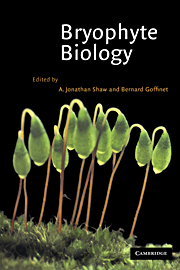Book contents
- Frontmatter
- Contents
- List of contributors
- Preface
- 1 Anatomy, development, and classification of hornworts
- 2 Morphology and classification of the Marchantiophyta
- 3 Morphology and classification of mosses
- 4 Origin and phylogenetic relationships of bryophytes
- 5 Chemical constituents and biochemistry
- 6 Molecular genetic studies of moss species
- 7 Control of morphogenesis in bryophytes
- 8 Physiological ecology
- 9 Mineral nutrition, substratum ecology, and pollution
- 10 Peatlands: ecosystems dominated by bryophytes
- 11 Role of bryophyte-dominated ecosystems in the global carbon budget
- 12 Population ecology, population genetics, and microevolution
- 13 Bryogeography and conservation of bryophytes
- Index
8 - Physiological ecology
Published online by Cambridge University Press: 05 June 2012
- Frontmatter
- Contents
- List of contributors
- Preface
- 1 Anatomy, development, and classification of hornworts
- 2 Morphology and classification of the Marchantiophyta
- 3 Morphology and classification of mosses
- 4 Origin and phylogenetic relationships of bryophytes
- 5 Chemical constituents and biochemistry
- 6 Molecular genetic studies of moss species
- 7 Control of morphogenesis in bryophytes
- 8 Physiological ecology
- 9 Mineral nutrition, substratum ecology, and pollution
- 10 Peatlands: ecosystems dominated by bryophytes
- 11 Role of bryophyte-dominated ecosystems in the global carbon budget
- 12 Population ecology, population genetics, and microevolution
- 13 Bryogeography and conservation of bryophytes
- Index
Summary
Introduction
Bryophytes share much of their physiology with other green land plants, but there are also important differences; the similarities and differences do not necessarily fall in line with simple expectations. Because most bryophytes have “stems” and “leaves,” and tradition has regarded them as “lower” plants, it is too easy to think of them as underdeveloped miniatures of vascular plants – as organisms that have evolutionarily not yet “made the grade.” Raven (1977,1984) has emphasized the importance of supracellular transport systems in the evolution of land plants, and the physiological correlates that we must read alongside the anatomical structures of fossil plants. But the highly differentiated supracellular conducting systems exemplified by xylem and phloem are really only a prerequisite for large land plants. For simple physical reasons of scale, conduction of water and metabolites in bryophytes can be much more diffuse. Similarly, bryophyte and vascular-plant leaves and leafy canopies must be thought through and compared as photosynthetic systems from first principles, not by simple analogies between structures operating at radically different scales, which can be seriously misleading.
In adapting to the erratic subaerial supply of water, vascular land plants evolved xylem, bringing water from the soil to meet the needs of the above-ground shoots and leaves. Bryophytes in general adopted the alternative strategy of evolving desiccation tolerance, photosynthesizing and growing during moist periods and suspending metabolism during times of drought. These two patterns of adaptation are in many ways complementary.
- Type
- Chapter
- Information
- Bryophyte Biology , pp. 225 - 247Publisher: Cambridge University PressPrint publication year: 2000
- 55
- Cited by



